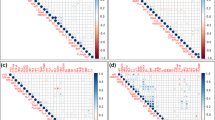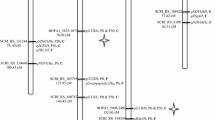Abstract
Modifying plant root systems is considered a means of crop improvement targeted to low-resource environments, particularly low nutrient and drought-prone agriculture. The identification of quantitative trait loci (QTLs) for root traits has stimulated marker-assisted breeding to this end, but different QTLs have been detected in different populations of the same species, and importantly, in the same population when grown in different experimental environments. The presence of QTL × environment interaction is implicated, and this must be characterised if the utility of the target QTLs is to be realised. Previous attempts to do this suffer from a lack of control over replicate environments and inadequate statistical rigour. The Bala × Azucena mapping population was grown in two replicate experiments of four treatment environments, a control, a low light, a low soil nitrogen and a low soil water treatment. After a 4 weeks growth, maximum root length, maximum root thickness, root mass below 50 cm, total plant dry mass, % root mass and shoot length were measured. A summary of the overall results is presented in an accompanying paper. Here, QTL analysis by composite interval mapping is presented. A total of 145 QTLs were detected, mapping to 37 discrete loci on all chromosomes. Superficial evidence of QTL × E (great difference in LOD score) was tested by single-marker analysis which confirmed QTL × E for five loci representing only five individual trait-loci interactions. Some loci appeared to be stable across environments. Some QTLs were clearly more or less active under low light, low nitrogen or drought. A few notable loci on chromosomes 1, 2, 3, 5, 7 and 9 are briefly discussed. Also discussed are some remaining statistical shortcomings that will be addressed in another companion paper.


Similar content being viewed by others
References
Broman KW, Wu H, Sen S, Churchill GA (2003) R/qtl: QTL mapping in experimental crosses. Bioinformatics 19:889–890
Champoux MC, Wang G, Sarkarung S, Mackill DJ, O’Toole JC, Huang N, McCouch SR (1995) Locating genes associated with root morphology and drought avoidance in rice via linkage to molecular markers. Theor Appl Genet 90:969–981
Hemamalini GS, Shashidhar HE, Hittalmani S (2000) Molecular marker assisted tagging of morphological and physiological traits under two contrasting moisture regimes at peak vegetative stage in rice (Oryza sativa L.). Euphytica 112:69–78
Ho MD, McCannon BC, Lynch JP (2004) Optimization modeling of plant root architecture for water and phosphorus acquisition. J Theor Biol 226:331–341
Jansen RC (1994) Controlling the type I and type I1 errors in mapping quantitative trait loci. Genetics 138:871–881
Jansen RC, Van Ooijen JW, Stam P, Lister C, Dean C (1995) Genotype by environment interaction in genetic mapping of multiple quantitative trait loci. Theor Appl Genet 91:33–37
Kamoshita A, Wade LJ, Ali ML, Pathan MS, Zhang J, Sarkarung S, Nguyen HT (2002a) Mapping QTLs for root morphology of a rice population adapted to rainfed lowland conditions. Theor Appl Genet 104:880–893
Kamoshita A, Zhang JX, Siopongco J, Sarkarung S, Nguyen HT, Wade LJ (2002b) Effects of phenotyping environment on identification of quantitative trait loci for rice root morphology under anaerobic conditions. Crop Sci 42:255–265
Lebreton C, Lazic-Jancic V, Steed A, Pekic S, Quarrie SA (1995) Identification of QTL for drought responses in maize and their use in testing causal relationships between traits. J Exp Bot 46:853–865
Li ZK, Yu SB, Lafitte HR, Huang N, Courtois B, Hittalmani S, Vijayakumar CHM, Liu GF, Wang GC, Shashidhar HE, Zhuang JY, Zheng KL, Singh VP, Sidhu JS, Srivantaneeyakul S, Khush GS (2003) QTL × environment interactions in rice. I. Heading date and plant height. Theor Appl Genet 108:141–153
Lopez-Bucio J, Cruz-Ramirez A, Herrera-Estrella L (2003) The role of nutrient availability in regulating root architecture. Curr Opin Plant Biol 6:280–287
MacMillan K, Emrich K, Piepho HS, Mullins CE, Price AH (2006) Assessing the importance of genotype × environment interaction for root traits in rice using a mapping population I. A soil-filled box screen. Theor Appl Genet. DOI 10.1007/s00122-006-0356-5
Malamy JE (2005) Intrinsic and environmental response pathways that regulate root system architecture. Plant Cell Environ 28:67–77
Malosetti M, Voltas J, Romagosa I, Ullrich SE, van Eeuwijk FA (2004) Mixed models including environmental covariables for studying QTL by environment interaction. Euphytica 137:139–145
Piepho H-P (2000) A mixed-model approach to mapping quantitative trait loci in barley on the basis of multiple environment data. Genetics 156:2043–2050
Piepho H-P (2005) Statistical tests for QTL and QTL-by-environment effects in segregating populations derived from line crosses. Theor Appl Genet 110:561–566
Price AH, Tomos AD (1997) Genetic dissection of root growth in rice (Oryza sativa L.) II: Mapping quantitative trait loci using molecular markers. Theor Appl Genet 95:143–152
Price AH, Steele KA, Moore BJ, Barraclough PB, Clarke LJ (2000) A combined RFLP and AFLP linkage map of upland rice (Oryza sativa L.) used to identify QTLs for root penetration ability. Theor Appl Genet 100:49–56
Price AH, Steele KA, Moore BJ, Jones RGW (2002) Upland rice grown in soil-filled chambers and exposed to contrasting water-deficit regimes: II. Mapping QTL for root morphology and distribution. Field Crops Res 76:25–43
Steele KA, Price AH, Shashidhar HE, Witcombe JR (2006) Marker-assisted selection to introgress rice QTLs controlling root traits into an Indian upland rice variety. Theor App Genet 112:208–221
Storey JD, Tibshirani R (2003) Statistical significance for genome-wide studies. Proc Natl Acad Sci USA 100:9440–9445
Tuberosa R, Salvi S, Sanguineti MC, Maccaferri M, Giuliana S, Landi P (2003) Searching for quantitative trait loci controlling root traits in maize: a critical appraisal. Plant Soil 255:35–54
Venuprasad R, Shashidhar HE, Hittalmani S, Hemamalini GS (2002) Tagging quantitative trait loci associated with grain yield and root morphological traits in rice (Oryza sativa L.) under contrasting moisture regimes. Euphytica 128:293–300
Wang DL, Zhu J, Li ZK, Paterson AH (1999) Mapping QTLs with epistatic effects and QTL × environment interactions by mixed linear model approaches. Theor Appl Genet 99:1255–1264
Zhang J, Zheng HG, Aarti A, Pantuwan G, Nguyen TT, Tripathy JN, Sarial AK, Robin S, Babu RC, Nguyen BD, Sarkarung S, Blum A, Nguyen HT (2001) Locating genomic regions associated with components of drought resistance in rice: comparative mapping within and across species. Theor Appl Genet 103:19–29
Zheng BS, Yang L, Zhang WP, Mao CZ, Wu YR, Yi KK, Liu FY, Wu P (2003) Mapping QTLs and candidate genes for rice root traits under different water-supply conditions and comparative analysis across three populations. Theor Appl Genet 107:1505–1515
Acknowledgment
This paper is an output from a project funded by the BBSRC (project no. P13058).
Author information
Authors and Affiliations
Corresponding author
Additional information
Communicated by F. van Eeuwijk
Rights and permissions
About this article
Cite this article
MacMillan, K., Emrich, K., Piepho, HP. et al. Assessing the importance of genotype × environment interaction for root traits in rice using a mapping population II: conventional QTL analysis. Theor Appl Genet 113, 953–964 (2006). https://doi.org/10.1007/s00122-006-0357-4
Received:
Accepted:
Published:
Issue Date:
DOI: https://doi.org/10.1007/s00122-006-0357-4




